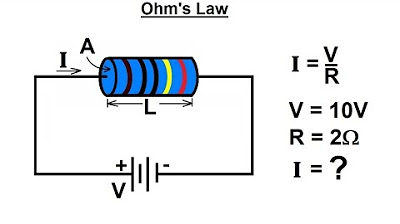Reto electronico: Saber intensidad Puente Wheatstone (clase 12.1)
Summary
TLDRIn this video, the presenter, Aurelio Cadena, challenges viewers to determine the current flowing through a 2-ohm resistor in an electrical circuit using a quick analysis method. He demonstrates how to solve the problem without a calculator by applying Thevenin's Theorem. Aurelio explains the process step by step, covering voltage division, equivalent resistances, and current calculation, ultimately providing the solution. The video also includes a tutorial on how to create and manage YouTube playlists, offering a helpful guide for users interested in organizing their content.
Takeaways
- 😀 The video presents a challenge where the viewer must determine the current passing through a 2kΩ resistor in a Winston bridge circuit.
- 😀 The speaker (Aurelio Cadena) uses a fast method to solve the circuit analysis problem without a calculator.
- 😀 The circuit involves using the Thevenin theorem to simplify the circuit and calculate the voltage and resistance between two terminals (A and B).
- 😀 Thevenin voltage is determined to be 2V by analyzing the resistors in the circuit and calculating the voltage divider.
- 😀 Thevenin resistance is calculated by removing the voltage sources and simplifying the resistances in the circuit, which includes resistors in parallel and series.
- 😀 When two resistors are in parallel, their equivalent resistance is found by multiplying them together and dividing by their sum.
- 😀 The speaker explains how to handle two equal resistors in parallel, noting that their equivalent resistance will be half of one of the resistors.
- 😀 The total Thevenin resistance is calculated as 4Ω by combining two resistances in series after simplifying the parallel resistors.
- 😀 The current through the circuit is then calculated using Ohm's Law, resulting in a current of 33.33mA, which is a simple calculation.
- 😀 The speaker emphasizes that this method does not require complex mesh analysis and can be done quickly with basic techniques.
- 😀 The latter part of the video provides a tutorial on creating a YouTube channel and adding videos to a playlist, demonstrating the process step by step.
Q & A
What is the main goal of the video?
-The main goal of the video is to demonstrate how to calculate the current passing through a 2-ohm resistor in a bridge circuit using the quickest method possible, without a calculator.
What type of circuit is used in the video to solve the problem?
-The circuit used is a Wheatstone bridge circuit, which is then simplified using Thevenin’s theorem to calculate the current.
How does the speaker simplify the circuit for analysis?
-The speaker disconnects the 2-ohm resistor from the original circuit and applies Thevenin’s theorem to replace the original complex circuit with an equivalent circuit consisting of a source and a resistance.
What is the significance of using Thevenin’s theorem in this problem?
-Thevenin's theorem simplifies the analysis of the circuit by reducing it to a single voltage source in series with a single resistance, making it easier to calculate the current through the 2-ohm resistor.
What is the voltage across the terminals A and B?
-The voltage across the terminals A and B is 2 volts, calculated by subtracting the voltage at point B (6V) from the voltage at point A (8V).
How is the resistance between terminals A and B calculated?
-The resistance between terminals A and B is calculated by first finding the parallel resistances of the 6-ohm and 3-ohm resistors, then the parallel resistances of the 4-ohm resistors, and finally adding them in series.
What formula is used to calculate the current in the circuit?
-The current is calculated using Ohm's Law, which states that current equals voltage divided by resistance. The total voltage (2V) is divided by the total resistance (6 ohms), resulting in a current of one-third of an ampere or 333 milliamps.
Why does the speaker mention the use of a calculator?
-The speaker mentions that a calculator is not necessary because the calculations involved are straightforward and can be done manually using basic principles like Ohm's Law and Thevenin’s theorem.
What is the role of the video tutorial at the end of the script?
-At the end of the script, the video tutorial shifts focus to guide viewers on how to create and manage a YouTube channel, add videos to a playlist, and organize content, providing useful tips for YouTube content creators.
How does the speaker suggest adding videos to a YouTube playlist?
-The speaker demonstrates how to add videos to a YouTube playlist by selecting videos, copying their links, and then inserting them into the playlist using YouTube's interface, ensuring the playlist is public and accessible to all viewers.
Outlines

This section is available to paid users only. Please upgrade to access this part.
Upgrade NowMindmap

This section is available to paid users only. Please upgrade to access this part.
Upgrade NowKeywords

This section is available to paid users only. Please upgrade to access this part.
Upgrade NowHighlights

This section is available to paid users only. Please upgrade to access this part.
Upgrade NowTranscripts

This section is available to paid users only. Please upgrade to access this part.
Upgrade NowBrowse More Related Video

Consider the circuit shown in the figure below

Electrical Engineering: Basic Laws (2 of 31) Ohm's Law

thevenin's theorem explanation | Thevenin's Theorem Solved Example Problem

Simple Combination Circuit with 8 resistors

KVL and KCL Examples (Circuits for Beginners #12)

Experimental Verification Of Ohm's Law and Finding Unknown Resistance | BOARD PRACTICAL | Std 10-12
5.0 / 5 (0 votes)